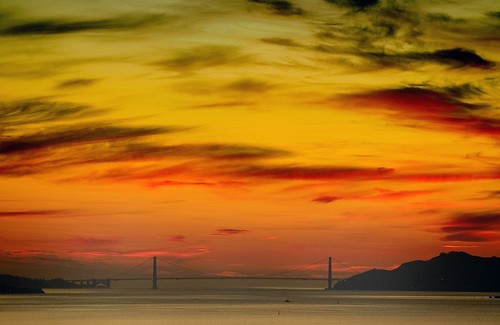Meta information: Nikon D70 Raw capture, AF-S VR-Zoom-Nikkor 70-200mm f/2.8G IF-ED at 200mm (200mm 35mm equivalence); tripod mounted and VR (vibration reduction) turned off.
Exif: ISO 200, 1/125 second, f/2.8.
Focus: Automatic, at infinity.
Post: Raw file processed twice (once for sky and once for foreground) and combined using a layer mask and gradient, minor cropping, routine level adjustments and sharpening, a dark blue gradient overlay used to enhance the sky.
If you look closely, you can see the first bridge lights coming on. As day turns to dusk, it is a good reminder that today–Thanksgiving in this country–is a good time to be home with our families, and to count our blessings. Whatever the dubious origins of this holiday (and more on this in a moment) it is a good time to remember what we individually have to be thankful for.
I am thankful for:
- Sunsets, clouds, and sunrises
- Digital photography, lenses, and computers
- My three healthy boys, and that (this year) they are all bigger than the turkey
- The wonderful Thanksgiving feast that Phyllis made
My list of things to be thankful for could obviously go on, as I personally have a great deal of blessings. But let me digress.
Julian has been on vacation from school the whole Thanksgiving week. I took him the other day to see a movie at the Bay Street Mall, which is in a heightened state of lets-start-Xmas early: a great deal of commercialism and more sales pressure than one usually experiences in American upscale shopping malls. (I can remember some real sales pressure in the souks of North Africa, but that’s another digression.)
Julian usually insists on exploring everything he comes across thoroughly, and the odd thing he found in this very blatantly commercial mall was an Ohlone Indian mound and timeline. Sitting just between P.J. Chang’s Chinese Bistro and Old Navy are a set of signs noting significant population changes in the Ohlone tribe.
Roughly, in 1769 before the Spaniards settled the area, there were 100,000 Ohlones in the Bay area, living on shell fish and native plants. They had villages in places like the mouth of Wildcat Creek, and navigated the waters and marshes of the Bay and delta.
Within twenty years of settlement from Europe, 25% of the indigeneous population had died of measles. It was downhill from there, until today all that is left of the Ohlones is a replica mound in a shopping mall.
I’m not really trying to be grumpy, but obviously the Thanksgiving on the part of the old world settlers of North America was at the expense of those here before them (this is not a novel observation on my part).
I think we should try hard in the season between Thanksgiving and Christmas not to succumb to the pressures of commerce, and to believe in the possibility of a world in which one people’s good fortune does not have to come at the cost of disaster for someone else.
